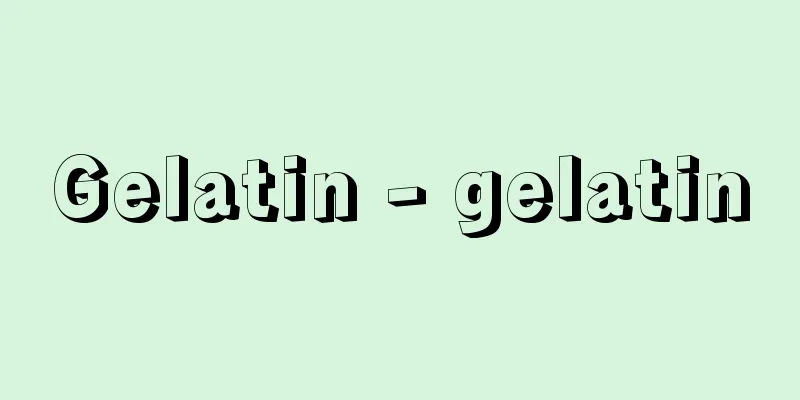Gelatin - gelatin

|
A type of gelling agent used to make jelly in cooking and confectionery. It is an induced protein made by heating collagen, a hard protein found in animal bones, skin, and tendons, with water to break it down and make it water-soluble. Gelatin is made from high-quality ingredients and is highly refined, pale and transparent, and is called edible gelatin, or refined gelatin. Gelatin that contains some impurities and is dark and opaque is called glue. The main raw materials used are cow bones and pig skin. The raw materials are soaked in lime water to remove the fat, then heated in a steam kettle to gelatinize the collagen, and the impurities are removed and it is dried. It is available in thin sheet and powder form depending on the drying method. Gelatin is mainly composed of protein and is a nutrient source, but since it lacks the essential amino acid tryptophan, it cannot be considered a good quality protein by itself. However, since it is rich in lysine, it has high utility as a protein when combined with wheat products that are low in lysine. [Tomomi Kono and Yonago Yamaguchi] Cooking and usesGelatin only swells in cold water, but dissolves in warm water and turns into gel when cooled further. Taking advantage of this property, gelatin is mainly used in cooking and confectionery to make gelatin jelly. The concentration to solidify into a jelly varies depending on what is to be solidified, but is usually 2-3%. First, soak the gelatin in water, allow it to absorb enough water, then add water and heat. Gelatin dissolves well at around 60°C. If it is boiled, its properties change and it becomes difficult to gel. Also, when the hydrogen ion concentration index (pH) of the gelatin solution reaches its isoelectric point at around 4, it does not gel properly. Care should be taken when adding fruit juice or fruit and it becomes slightly sour. Also, if raw pineapple, papaya, kiwi fruit, fig, and other fruit pulp containing proteolytic enzymes is mixed, gelatin, which is a protein, is broken down and does not gel. Gelatin has a low coagulation temperature. It needs to be kept at around 10°C or less, depending on the concentration. It takes several hours or more to gel. Gelatin is used in a variety of jelly sweets, assorted dishes, and as a decoration for cold dishes, as well as an ice cream stabilizer, a binding agent for ham and sausages, and a bulking agent for general protein foods (such as fish paste products).In addition to its edible uses, gelatin is also used in photographic films, solid culture media, hemostatic agents, medicinal capsules, and more. [Tomomi Kono and Yonago Yamaguchi] "Glue and Gelatin: Industrial History and Science and Technology" edited by Yoshihiro Abiko et al., Revised Edition (1997, Japan Glue and Gelatin Industry Association) [References] | | | | |Source: Shogakukan Encyclopedia Nipponica About Encyclopedia Nipponica Information | Legend |
|
調理や製菓でゼリー形成に用いるゲル化剤の一種。動物の骨や皮、腱(けん)などに含まれる硬タンパク質のコラーゲンを水とともに加熱して分解し、水溶性にした誘導タンパク質。良質の材料を用い精製度が高く、淡色透明のものが食用ゼラチンで、精製ゼラチンともいう。多少の不純物を含み、濃色不透明のものは膠(にかわ)という。原料にはおもにウシの骨、ブタの皮などが用いられる。原料を石灰水に浸して脂肪を除去したあと、蒸気釜(がま)で加熱してコラーゲンをゼラチン化し、不純物を除いて乾燥する。乾燥法により、薄板状と粉末状がある。 ゼラチンの主成分はタンパク質で、栄養源となるが、必須(ひっす)アミノ酸のうちトリプトファンを欠くため、これだけでは良質のタンパク質とはいえない。しかし、リジンが多いので、リジンの少ない小麦製品と組み合わせてとると、タンパク質としての利用価値が高くなる。 [河野友美・山口米子] 料理と用途ゼラチンは冷水には膨潤するだけだが、温水には溶け、さらに冷却するとゼリー化する。この性質を利用して、料理や製菓では主としてゼラチンゼリーに用いられる。ゼリー状に固めるときの濃度は、固めようとするものにより差はあるが、通常2~3%である。まずゼラチンを水につけ、十分吸水させてから水を加えて加熱する。ゼラチンは60℃前後でよく溶ける。沸騰させると性質が変わり、ゼリー化しにくくなる。またゼラチン液は水素イオン濃度指数(pH)が4前後になると等電点となり、きれいにゼリー化しない。果汁や果物を加えてわずかに酸味のついたときは注意が必要である。また、タンパク質分解酵素を含む生(なま)のパイナップル、パパイヤ、キウイフルーツ、イチジクなどの果肉を混ぜると、タンパク質であるゼラチンは分解されてゼリー化しない。ゼラチンの凝固温度は低い。濃度にもよるが、ほぼ10℃以下にする必要がある。ゼリー化には数時間以上を要する。ゼラチンは、各種ゼリー菓子、寄せ物、冷製料理の飾りなどのほか、アイスクリームの安定剤、ハム、ソーセージの結着剤、一般のタンパク質性食品(魚肉練り製品など)の増量剤、食用以外には写真感光膜、固形培地、止血剤、薬用カプセル剤などにも使用される。 [河野友美・山口米子] 『安孫子義弘他編『にかわとゼラチン 産業史と科学技術』改訂版(1997・日本にかわ・ゼラチン工業組合)』 [参照項目] | | | | |出典 小学館 日本大百科全書(ニッポニカ)日本大百科全書(ニッポニカ)について 情報 | 凡例 |
<<: Cerrado - Cerrado (English spelling)
>>: Ceratite (English spelling)
Recommend
Hiroteru Minagawa
1548-1628 * Azuchi-Toyotomi - A military commande...
Kenkichi Kataoka
A liberal and civil rights activist. Born on Dece...
Statue of a god
The gods of Jingi faith are depicted in sculpture...
lokapala (English spelling)
...He is also said to be a household deity who be...
Cohen, Stanley
[Born] November 17, 1922. New York, New York. Bioc...
One-step revolution - ichidan kaikakumei
...a debate within the Marxist camp from the late...
Liebault, AA (English spelling)
…Although Blade’s theory is not accepted in its c...
Ogori ruins
...In the second half of the 8th century, buildin...
Zeolite (English spelling)
It is also called zeolite. It is a hydrous alumin...
Tajik - Tajikgo (English spelling)
Along with Persian, it is one of the western diale...
Mirror Image Canon
…It is also called the Crab Canon. (2) and (3) ar...
Takakage Shijo
Year of death: 3rd year of Joji/19th year of Shohe...
Waves - Harou
A general term for wind waves that occur when win...
Ibikyo Gorge
(Ibigawa Town, Ibi District, Gifu Prefecture) A to...
Sosho
Year of death: 6/8/1278 (6/29/1278) Year of birth:...









